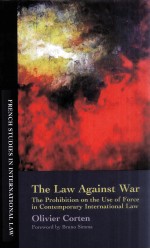

THE LAW AGAINST WAR THE PROHIBITION ON THE USE OF FORCE IN CONTEMPORARY INTERNATIONAL LAWPDF电子书下载
- 电子书积分:17 积分如何计算积分?
- 作 者:OLIVIER
- 出 版 社:OXFORD AND PORTLAND,OREGON
- 出版年份:2010
- ISBN:
- 页数:569 页
Introduction 1
1 A Choice of Method 4
Ⅰ The Terms of the Methodological Debate on the Non-Use of Force: the Extensive Versus the Restrictive Approach 5
A.The Extensive Approach to the Customary Prohibition of the Use of Force 6
B.The Restrictive Approach to the Customary Prohibition of the Use of Force 15
Ⅱ Methodological Approach of this Book 27
A.Reliance on a Novel Right 29
B.The Acceptance of the Modification of the Legal Rule by the International Community of States as a Whole 34
2 What do ‘Use of Force’ and ‘Threat of Force’ mean? 50
Ⅰ What does’Force’ mean? 51
A.The Boundary between Military Force and Police Measures 52
B.Determining the Threshold: ‘Force’ within the Meaning of Article 2(4) of the Charter 66
Ⅱ What does ‘Threat of Force’ mean? 92
A.The Restrictive Meaning of ‘Threat’ under Article 2(4) of the Charter 93
B.The Scope of the Prohibition of Threat: the Absence of any Specific Regime for the Contemplated Use of Force 111
3 Do the Prohibition of the Use of Force and Self-defence Apply to Non-State Actors? 126
Ⅰ Exclusion of Non-State Political Entities from the Rule’s Scope of Application 127
A.Inapplicability of the Rule Prohibiting the Use of Force to Civil Wars 127
B.Inapplicability of the Rule to National Liberation Struggles 135
C.The Case of Territories with Entities of Controversial Legal Status 149
Ⅱ Exclusion of Private Groups from the Rule’s Scope of Application 160
A.Maintaining ‘International Relations’ as Relations among States: the Letter and Spirit of the Rule 162
B.Maintaining ‘International Relations’ as Relations between States: the Interpretation of Texts in Practice 174
C.Maintaining ‘International Relations’ as Relations between States: the Works of the International Law Commission and of the International Court of Justice 186
4 Can Circumstances Precluding Unlawfulness be Invoked to Justify a Use of Force? 198
Ⅰ Inadmissibility in Principle 199
A.The Peremptory Character of the Rule in Article 2(4) of the Charter 200
B.Inadmissibility of Circumstances Precluding Unlawfulness Not Provided for by the Charter 213
Ⅱ Inadmissibility Confirmed in Practice 225
A.Precedents Attesting to States’ General Reluctance to Invoke Circumstances Precluding Unlawfulness 225
B.Precedents Attesting Unequivocal Condemnation of Armed Reprisals 234
C.The Rare Precedents where Circumstances Precluding Unlawfulness have been Invoked to Justify the Use of Force 236
5 Intervention by Invitation 249
Ⅰ The General Legal Regime of Military Intervention by Invitation 250
A.The Possibility of Consenting to Armed Intervention within the Limits of Peremptory Law (fus Cogens) 250
B.The Requirement for Consent of the State’s Highest Authorities 259
C.The Existence of ‘Validly Given’ Consent 266
Ⅱ The Legal Regime of Military Intervention by Invitation in an Internal Conflict 276
A.The Problem of Concurrent Governments 277
B.The Problem of the Purpose of the Intervention by Invitation 288
6 Intervention Authorised by the UN Security Council 311
Ⅰ The General Legal Regime of Authorised Military Intervention 312
A.The Lawfulness of Military Intervention Authorised by the Security Council 312
B.The Unlawfulness of Military Intervention ‘Authorised’ by Another UN Body or by Another Subject of International Law 329
Ⅱ The Problem of Presumed Authorisation 348
A.The Absence of Recognition of Presumed Authorisation in Practice 349
B.Refusals and Obstacles of Principle to Recognition of a Presumed Authorisation 390
7 Self-Defence 401
Ⅰ ’Armed Attack’ According to Article 51 of the Charter 402
A.‘Preventive Self-Defence’ Theories 406
B.The Question of ‘Indirect Aggression’ 443
Ⅱ Necessity and Proportionality 470
A.The Limit of Necessary Measures Adopted by the Security Council 472
B.The General Meaning of Conditions of Necessity and Proportionality 479
8 A Right of Humanitarian Intervention? 495
Ⅰ Non-Recognition in Legal Texts 497
A.The Dismissal of the Right of Humanitarian Intervention in Classical Legal Texts 498
B.The Persistent Refusal to Accept a ‘Right of Humanitarian Intervention’ 511
Ⅱ The Non-Existence of Decisive Precedents 526
A.The Absence of Consecration of a Right of Humanitarian Intervention before 1990 527
B.The Absence of Consecration of a Right of Humanitarian Intervention since 1990 537
Conclusion 550
Selected Reading 555
Index 559
- 《童子与魔法 钢琴女王玛塔·阿格里奇传》(法)奥利维耶·贝拉米(Olivier Bellamy)著 2014
- 《宏观经济学 高级教程》(美)布兰查德(Blanchard,Olivier Jean),(美)费希尔(Fischer,Stanley)著;刘树成等译 1992
- 《宏观经济学》Olivier Blanchard 1997
- 《营养减压 食物减压和享受生活的方式》(英)苏珊娜·奥利维尔(Suzannah Olivier)著;刘骏译 2004
- 《儿童启蒙百科 人类与社会》Florence and Pierre-Olivier wessels著 1995
- 《信用风险 度量与管理》(美)阿诺·德·瑟维吉尼(Arnaud de Servigny),(美)奥里维尔·雷劳特(Olivier Renault)著;任若恩等译 2005
- 《宗教改革 路德、加尔文和新教徒》(法)Olivier Christin原著;花秀林译 2003
- 《粉色星球 中法文本》(法)奥利维埃·瓦蒂纳(Olivier Vatine)绘;赵勇权译 2004
- 《凡尔纳带着我们旅行 凡尔纳评传》(法)奥利维埃·迪马(Olivier Dumas)著;蔡锦秀,章晖译 2003
- 《从文本到行动 保尔·利科传》(法)蒙甘(Olivier Mongin)著;刘自强译 1999
